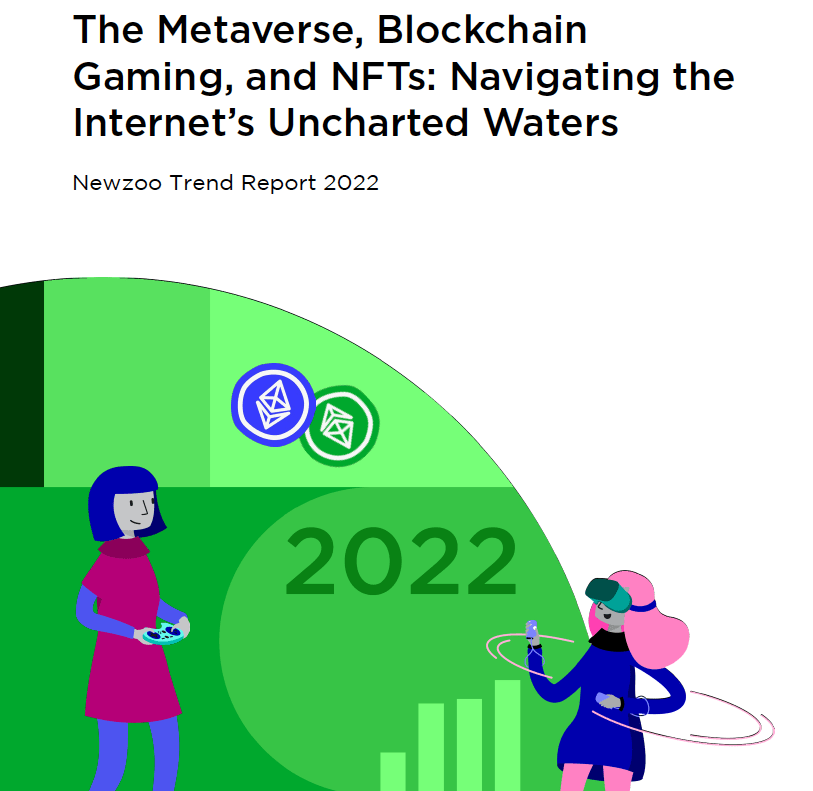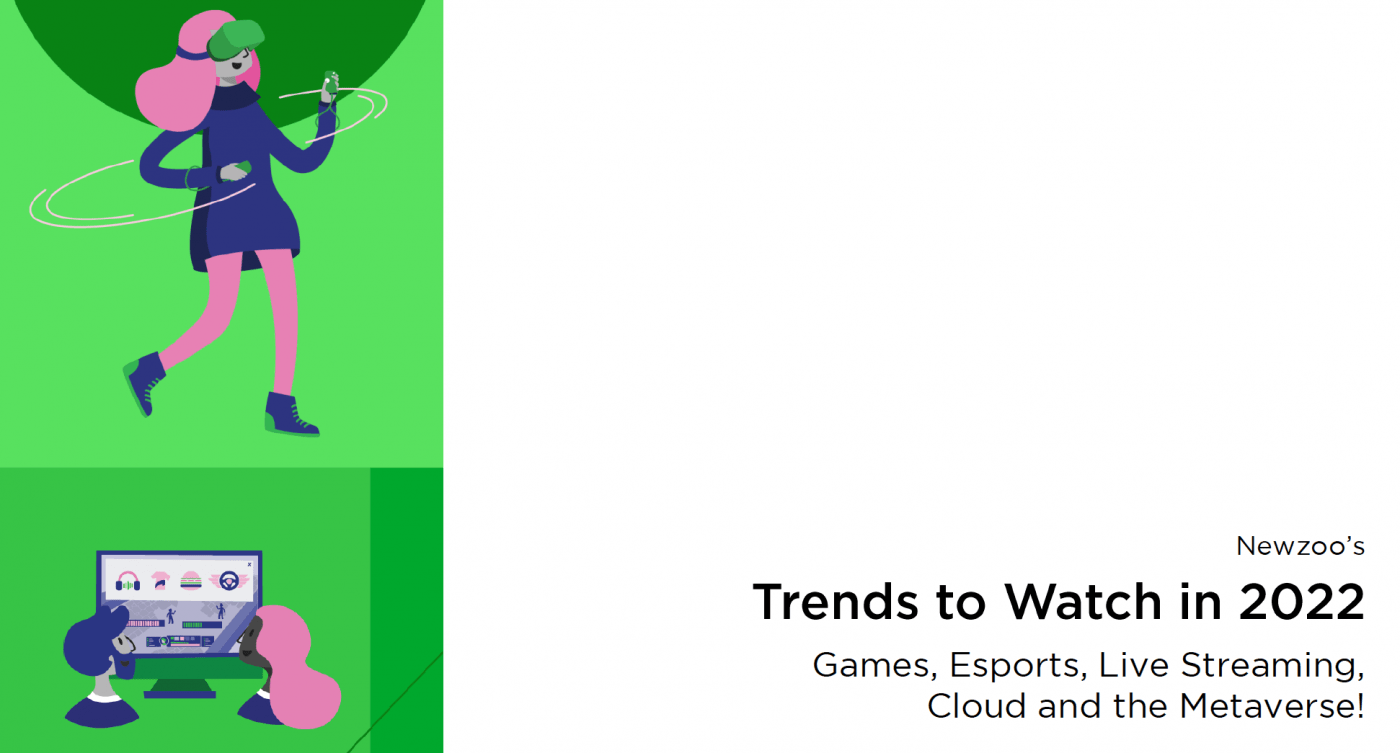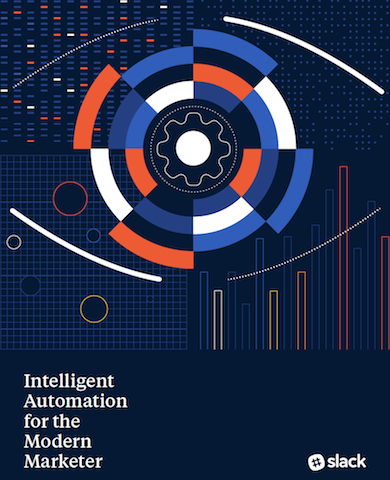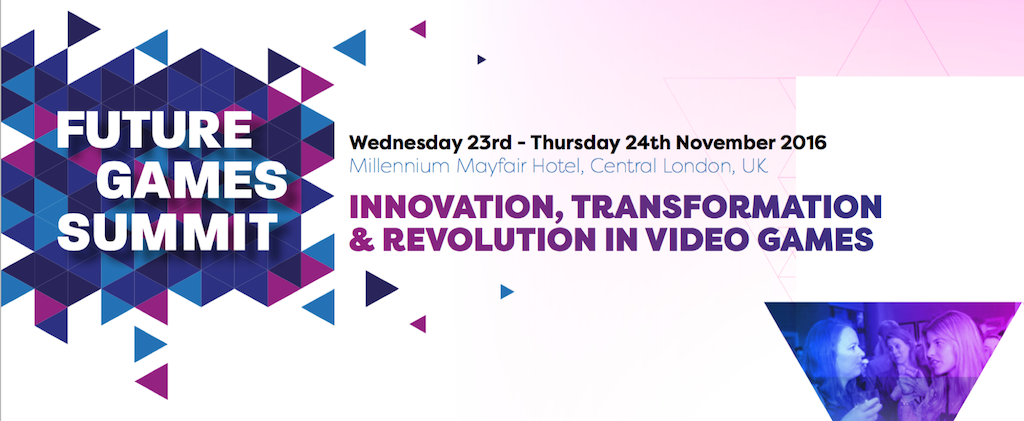The Metaverse, Blockchain Gaming, and NFTs Trend Report 2022
The transition from Web2.0 to Web 3.0 will impact the modus operandi of (major) brands and how consumers live, work, and experience entertainment. Given this space’s fast-moving, a basic understanding of the building blocks and trends surrounding it is essential. Therefore, The Metaverse, Blockchain Gaming, and NFTs Trend Report 2022 identifies and discusses the top 10 prevailing trends in each space. Understanding these trends (and what drives them) will help companies endemic to gaming, consumer brands, and consumers alike to navigate the murky waters of the metaverse, along with its connection to NFTs and blockchain games.
The evolution of simulated, 3D worlds presents a massive opportunity for brands. The transition from diffused physical spaces into virtual worlds allows them to reach a highly condensed mass of users more difficult to both approach and monetize through other forms of advertising. This transition into virtual worlds can only accelerate as the current generations of digital natives age and as virtual experiences become more authentic. Fast-moving brands like Nike, Louis Vuitton, Balenciaga, or technology brands like Meta—to name a few—recognised this shifting of the tide and have already developed metaverse strategies.
Moreover, while NFTs and blockchain games have experienced a spectacular 2021, a severe drawback in the crypto market and fears of a global recession have led to the public interest and coin valuations substantially waning in recent months. As a result, this correction will likely end most of the (low effort) endeavors in these areas. Nevertheless, Newzoo (the report’s authors) remains optimistic about the future and confident that the top projects will succeed.
The metaverse, blockchain gaming, and NFTs – key global trend summary
- Big Tech and Brand Involvement
- Consumers spend increasingly more time in virtual worlds, and successful brands follow them. As a result, consumer-facing companies will be forced to develop a metaverse strategy to stay connected with their (future) customers and remain relevant.
- Since there is no single “right” approach to tackling the metaverse, different brands have approached it in distinct ways. Now, these can range from IP activations inside virtual worlds and acquiring virtual land NFTs to outright M&As.
- Roblox: A Peek into the Future of Virtual Worlds
- As gaming has increasingly transitioned towards a multi-layered experience that encompasses viewing, playing, and socialising, Roblox has become one of the most popular games on the planet and has managed to attract large numbers of creators, players, events, and brands to its ecosystem. By analysing its success, we can draw important lessons and better understand the direction that the virtual worlds of the future should (not) take.
- For all the praise it received, Roblox only allows developers building on its platform to retain just above 25% of the revenue they generate. The evolution of pay structures will be interesting to monitor, particularly considering the bad publicity that Meta received for announcing an almost 50% take rate for developers building on its proprietary virtual world, Horizon Worlds.
- The Future of Music and Entertainment
- The inability of artists to go on tour during the COVID-19 pandemic has forced them to seek alternative revenue streams. Consequently, the last year has seen several high-profile musical events in virtual worlds like Fortnite or Roblox, which managed to pique the interest of millions of fans around the world.
- Music NFTs are an alternative way for artists—most of whom depend on extractive record labels and centralized platforms to earn a living—to increase their earning potential. This allows them to sell their singles, EPs, or albums as NFTs to their most loyal fans.
- The Future of Fashion and Luxury Brands
- As time spent in virtual worlds increases, our digital identity and representation will grow in importance. This opens a wide array of opportunities for traditional and digital fashion brands alike to dress our digital selves with in-game skins and virtual garments, thus giving rise to the direct-to-avatar business model.
- This also has important implications for the future of e-commerce. As the transition to digital accelerates, consumers will want the choice of shopping in immersive online environments that feature photo-realistic representations of a brand’s physical garments, again increasing the incentives for fashion brands to invest in their digital presence.
- Play to Earn (P2E) and Blockchain Gaming
- The early market for blockchain games is overrun by titles with rudimentary gameplay without sustainable economies. This is natural, as complex gaming experiences take time to develop. As time passes, we are likely to see more blockchain games challenge traditional AAA titles in terms of technical complexity and—at some point—the size of the player base.
- Though blockchain gaming faces some notable challenges—particularly sustainability and regulatory concerns—these are likely to be mitigated as the space matures.
- P2E Guilds and the Future of Work
- Play to earn guilds have exploded in popularity in the last year. Their activities revolve around acquiring and then loaning in-game assets to players who cannot otherwise afford the high entry barriers of some blockchain-based titles. Their services are generally popular in growth markets and usually depend on blockchain games offering players enough (financial) incentives to engage with them.
- The future of work in the virtual realm extends beyond just gaming. As synthetic environments and digital twin technologies—among others—become more advanced, a wide range of “metaverse” native jobs will emerge to sustain our alternate digital lives.
- The Rush for Digital Real Estate
- The last 12 months have seen major brands like Samsung, Adidas, and Gucci jumping on the bandwagon of digital-land NFTs. Acquiring digital real estate is essentially a bet on the blockchain-based virtual worlds gaining in popularity but is also a low-risk way for major companies to ensure they will be where their clientele is, should this become a wide-ranging phenomenon in the future.
- An Introduction to NFT Collections
- 2021 has undeniably been the year of NFTs, with several high-profile collections being sought after for the boost in social status and financial incentives they offered. Despite the current market pullback, profile picture (PFP) NFTs are likely to be key elements when it comes to digital identity in the metaverse.
- PFP NFTs are only a subset of the whole digital asset offering; virtual land, in-game items, art, or utility NFTs are also popular among market participants.
- The Transition from NFT Collections to Global IP
- The Bored Ape Yacht Club (BAYC) is an NFT collection made up of 10,000 cartoon apes. Since its launch, it has generated significant interest from celebrities and high-profile individuals (though several celebrities were gifted their BAYC NFTs), being one of the first NFT brands that managed to permeate into mainstream culture through music, events, partnerships, and its dedicated network of individuals. This has prompted an increasing number of NFT projects to extend their scope and become transmedia IPs that span across multiple verticals.
- Loot is an exercise in decentralised IP building. Its evolution is fully controlled by its community at large; everyone can build applications that enrich the Loot ecosystem and bring it one step closer to becoming a major IP. Loot began a movement that was then quickly adopted by other notable projects—like Treasure—that will likely reshape how some future brands are born and evolve.
- Crypto and the Promise of Interoperability
- Despite its limitations, Ethereum—alongside its sidechains and layer 2s -is currently the backbone of a sizable portion of the NFT & blockchain gaming space. With the Ethereum merge –which will transition the blockchain from the unsustainable proof of work toward proof of stake –on the horizon, it is poised to continue its rule as the dominant smart contract platform.
- While interoperability at scale across games continues to be a hot topic among metaverse enthusiasts, the path to adoption is currently filled with notable technical and political roadblocks. Nevertheless, interoperability can potentially become a reality as shared standards are being built and as player interest grows.
Download the Metaverse, Blockchain Gaming, and NFTs Trend Report 2022
Click here to download The Metaverse, Blockchain Gaming, and NFTs Trend Report 2022. You may also be interested in The Future of Gaming Report 2022. Click here to read more.
If you’re looking for advice from a gaming, metaverse, and/or esports agency, Strive Sponsorship can help. Contact us for sports, gaming, metaverse, esports strategy, sponsorship, commercial, content, operations, investment, and communications consultancy services.
Frequently asked questions
What is the metaverse?
Respected thinker, author and investor, Matthew Ball, defines the metaverse as “a massively scaled and interoperable network of real-time rendered 3D virtual worlds which can be experienced synchronously and persistently by an effectively unlimited number of users with an individual sense of presence, and with continuity of data, such as identity, history, entitlements, objects, communications, and payments.”
Does the metaverse exist yet?
No. Individual virtual worlds and experiences exist but they are not interoperable presently.
Who owns the metaverse?
No one, just like no one owns the internet. Various entities own aspects of what may become components of the metaverse in time e.g. The Sandbox, Decentraland etc.














